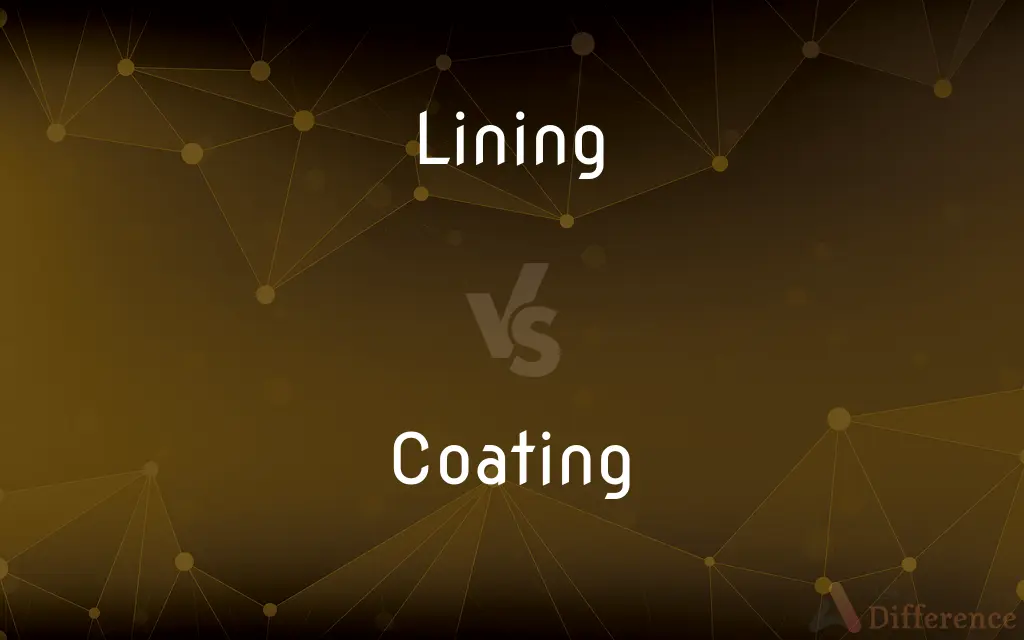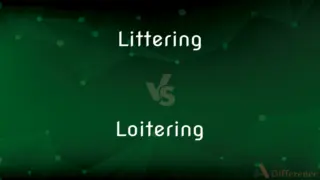Lining vs. Coating — What's the Difference?
By Maham Liaqat & Fiza Rafique — Updated on April 18, 2024
Lining involves applying a material to the inner surfaces for protection or functionality, while coating refers to covering any surface with a layer to protect or decorate it.

Difference Between Lining and Coating
Table of Contents
ADVERTISEMENT
Key Differences
Lining is primarily used to protect the inner surfaces of containers or equipment from corrosion, abrasion, or leakage, whereas coating is applied on both inner and outer surfaces for protection, decoration, or specific functional attributes.
In industrial applications, linings are often thick layers of material such as rubber or ceramic that are bonded to the substrate to provide a barrier against harsh conditions, while coatings can be thin layers like paint or varnish used mainly for aesthetic purposes or light environmental protection.
Linings are crucial for extending the life and functionality of equipment in industries such as chemical processing and wastewater management, on the other hand, coatings are extensively used across various sectors including automotive, construction, and manufacturing for surface enhancement and longevity.
The process of lining typically requires more material and can be more labor-intensive and specialized depending on the application, whereas coating processes are generally less complex and can be applied more quickly and economically.
While both linings and coatings serve to protect materials, the choice between them depends on the specific needs of the application, such as the level of protection required, the type of environment, and budget constraints.
ADVERTISEMENT
Comparison Chart
Application Surface
Primarily inner surfaces
Both inner and outer surfaces
Thickness
Generally thicker
Typically thinner
Purpose
Protection against harsh internal conditions
Protection, decoration, or functionality
Industries
Chemical, wastewater management
Automotive, construction, manufacturing
Application Complexity
More labor-intensive and specialized
Less complex, more economical
Compare with Definitions
Lining
A material used to shield the inner surface from damage.
They added a plastic lining to enhance durability.
Coating
A layer of paint or other material applied on surfaces.
The wood received a coating of varnish.
Lining
The process of installing a barrier inside equipment.
Lining the pipes extended their operational life.
Coating
A film covering an object for protective reasons.
The metal coating prevents rusting.
Lining
A protective layer applied inside a container or part.
The tank's lining prevents chemical corrosion.
Coating
The act of applying a protective or decorative layer.
Coating the sculpture took several hours.
Lining
A covering inside garments for comfort and fit.
The silk lining in her jacket made it comfortable.
Coating
A finishing touch on baked goods for aesthetic appeal.
The donut has a chocolate coating.
Lining
A layer inside automotive components for noise reduction.
The car's trunk had a lining to reduce noise.
Coating
A thin cover on electronic components for insulation.
The circuit board has a coating for safety.
Lining
A layer of different material covering the inside surface of something
Self-clean oven linings
Coating
A coating is a covering that is applied to the surface of an object, usually referred to as the substrate. The purpose of applying the coating may be decorative, functional, or both.Paints and lacquers are coatings that mostly have dual uses of protecting the substrate and being decorative, although some artists paints are only for decoration, and the paint on large industrial pipes is presumably only for the function of preventing corrosion.
Lining
A covering or coating for an inside surface
The jacket had a patterned lining.
Coating
A layer of a substance spread over a surface as for protection or decoration; a covering layer.
Lining
Material used for such covering or coating.
Coating
Cloth for making coats.
Lining
A covering for the inside surface of something.
Coating
A thin outer layer.
They painted on a coating to protect it from the weather.
Lining
The material used for such a covering.
Coating
(archaic) Cloth for making coats.
Lining
The act of attaching such a covering.
Coating
A telling-off; a reprimand.
Lining
Present participle of line
Coating
Present participle of coat
We spent hours coating the truffles with cocoa powder so they wouldn't be sticky.
Lining
The act of one who lines; the act or process of making lines, or of inserting a lining.
Coating
A coat or covering; a layer of any substance, as a cover or protection; as, the coating of a retort or vial.
Lining
That which covers the inner surface of anything, as of a garment or a box; also, the contents of anything.
The lining of his coffers shall make coatsTo deck our soldiers.
Coating
Cloth for coats; as, an assortment of coatings.
Lining
A protective covering that protects an inside surface
Coating
A thin layer covering something;
A second coat of paint
Lining
A piece of cloth that is used as the inside surface of a garment
Coating
A decorative texture or appearance of a surface (or the substance that gives it that appearance);
The boat had a metallic finish
He applied a coat of a clear finish
When the finish is too thin it is difficult to apply evenly
Lining
Providing something with a surface of a different material
Coating
A heavy fabric suitable for coats
Lining
The act of attaching an inside lining (to a garment or curtain etc.)
Coating
The work of applying something;
The doctor prescribed a topical application of iodine
A complete bleach requires several applications
The surface was ready for a coating of paint
Common Curiosities
What is a common use of coatings in electronics?
To insulate and protect components from environmental exposure.
Can lining be considered a type of coating?
Yes, lining is a specialized type of coating applied to internal surfaces for protection.
Is environmental impact a consideration in choosing between lining and coating?
Yes, the environmental impact and safety regulations can influence the choice.
What materials are commonly used for linings?
Rubber, plastics, ceramics, and specialized polymers are commonly used.
Why might an industry choose lining over coating?
For better protection against harsh internal environments.
How does the application process differ for linings and coatings?
Lining processes are more complex and specialized, whereas coatings can be simpler and more widespread.
What is the primary function of lining?
To protect the internal surfaces of containers or equipment from damage.
How does coating differ from painting?
Coating includes all types of surface finishes, whereas painting specifically involves applying paint for color and protection.
Are coatings always thinner than linings?
Typically, yes, because coatings need to be less intrusive and economical.
Can linings be decorative?
Generally, linings are utilitarian, but in fashion, they can be both protective and decorative.
What types of coatings are used in the automotive industry?
Paints, varnishes, and lacquers for appearance and protection against corrosion.
Are there specific industries that prefer coatings over linings?
Yes, industries focusing on aesthetics and external surface protection, like construction and automotive.
Share Your Discovery

Previous Comparison
Run vs. Ran
Next Comparison
Littering vs. LoiteringAuthor Spotlight
Written by
Maham LiaqatCo-written by
Fiza RafiqueFiza Rafique is a skilled content writer at AskDifference.com, where she meticulously refines and enhances written pieces. Drawing from her vast editorial expertise, Fiza ensures clarity, accuracy, and precision in every article. Passionate about language, she continually seeks to elevate the quality of content for readers worldwide.














































